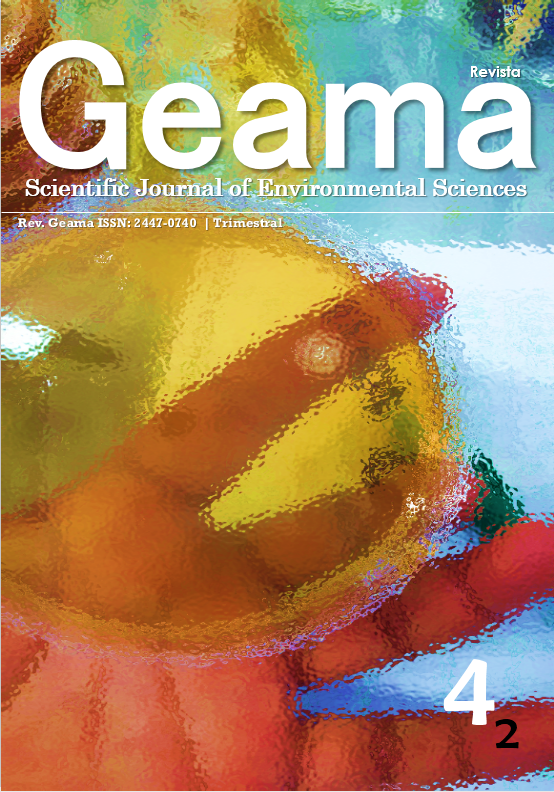Physico-Chemical Characterization and Dietary Fiber of Mango (Mangífera Indica L.) Grown in Northeast of Brazil
Resumo
Numerous studies show that eating fruits has been inversely linked with chronic disease, type hypertension and significant reduction in the risk of cardiovascular events. And this balanced natural combination of bioactive compounds present in fruits and vegetables cannot be mimicked by industrialized food. Therefore, it is important to encourage the consumption of natural foods, but for this we must know your existing content in foods. Three mangoes cultivars (Mangifera indica L.) were evaluated for physico-chemical characterization and dietary fiber during their development (unripe and ripe) and after post-harvest treatments. The results are in agreement with the evolution of the analyzed parameters between the development stages studied and show that regardless the post-harvest treatment, the fruits didn’t lose the ability to ripe. At the ripe stage, the highest total dietary fiber was presented by Espada and Tommy Atkins cvs. From these data, at quantitative level, mangoes can be considered a good source of dietary fiber, thus potentially beneficial to human health.Downloads
Referências
ALVES, R.E. et al. Colheita e pós-colheita. In: GENÚ,
P.J. de C.; PINTO, A.C. de Q.(Ed.). Acultura da
mangueira. Brasília: Embrapa, 2002. P. 381-405.
ANDRADE, F.A.; FIGUEIREDO NETO, A.; COSTA, J.D.S.;
COSTA, M.S.; SILVA, J.A.B.; ALMEIDA, F.A.C. Efeito
da injúria mecânica por impacto na qualidade
físico-química da manga Tommy Atkins.
Tecnologia & Ciência Agropecuária, v.10, n.1,
p.69-73, 2016.
BERNAUD, F.S.R.; RODRIGUES, T.C. Fibra alimentar –
Ingestão adequada e efeitos sobre a saúde do
metabolismo. Arq Bras Endocrinol Metab. v.57, n.6,
ASSOCIATION OF OFFICIAL ANALYTICAL CHEMISTRY.
(2002). Official methods of analysis of Association
of Official Analytical Chemistry Internacional.
Food Composition; Additives; Natural
Contaminantes. (17th. ed.); (4th rev.). Maryland:
AOAC Internacional.
DUTRA. P.R.S. (2004). Amido e sua inter-relação com
o desenvolvimento e ponto de colheita de
mangas (Mangífera indica, L.) cultivar Tommy
Atkins. PhD Thesis, Universidade Federal de
Pernambuco, Recife-Brasil.
FAO. Organização das Nações Unidas para a
Agricultura e Alimentação. FAOSTAT. Divisão de
estatística. 2013. Disponível em:
<http://faostat3.fao.org/download/Q/ QC/E>.
Acesso em: 02.03.2018.
FORSYTHE, S. J. Microbiologia da segurança
alimentar. Tradução de Maria Carolina Minardi
Guimarães; Cristina Leonhardt. Porto Alegre:
Artmed, 2002. 424 p.
MAIA, G.A., SILVA, M.F.A, HOLANDA, L.F.F.,
MONTEIRO, J.C.S., ORIÁ, H.F., FIGUEIREDO, R.W.
(1986). Estudo da maturação de algumas
variedades de manga (Mangifera indica L.).
Revista Brasileira de Fruticultura, 8, 2, 67-74.
MALTA, D.C.; BERNAL, R.T.I.; Andrade, S.S.C.A.;
SILVA, M.M.A.; VELASQUEZ-MELENDEZ, G.
Prevalência e fatores associados com hipertensão
arterial autorreferida em adultos brasileiros. Rev.
Saúde Pública v.51 supl.1 Epub June 01, 2017.
MENDEZ, M. H. M. , DERIVI, S.C.N. , RODRIGUEZ,
M.C.R. , FERNANDES, M.L. (1995). Tabela de
composição de alimentos. Niterói: Editora da UFF.
MORAES, D.M., PUSCHMAN, R., LOPES, N.F. (2000).
Respiração e desenvolvimento de fruto de
mangueira cv. Ubá. Revista Brasileira de
Fruticultura, 22 (Esp.), 37-41.
MORAIS, P.L.D. de, FILGUEIRAS, H.A.C., PINHO, J.L.N.
de, ALVES, R.E. (2002). Ponto de colheita ideal de
mangas “Tommy Atkins” destinadas ao mercado
europeu. Revista Brasileira de Fruticultura, 24, 3,
-675.
RAMULO, P. & RAO, P.U.(2003). Total, insoluble and
soluble dietary fiber contents of Indian fruits.
Journal of Food Composition and Analysis, 16, 677-
SAUCO, V.G. & GAUVAN, D.I. (1990). Differnes
between mango cultivars regarding their facility to
be halved and spoon-eaten, and association
witte fiber. Fruits, 45, 381-385.
SOUZA, J.P.de, PRAÇA, E.F., ALVES, R.E. , BELKIAN
NETO, F. , DANTAS, F.F. (2002). Influência do
armazenamento refrigerado em associação com
atmosfera modificada por filmes plásticos na
qualidade de mangas “Tommy Atkins”. Revista
Brasileira de Fruticultura, 24, 3, 665-668.
TAIZ, L. ZEIGER, E.(2004). Fisiologia vegetal, 3 ed.
Porto Alegre: Artmed.
VIDAL, M.F.; XIMENES, L.J.F. Comportamento
recente da fruticultura nordestina: área, valor da
produção e comercialização. Caderno Setorial
ETENE. ano 1, n. 2, outubro, 2016.
Downloads
Publicado
Como Citar
Edição
Seção
Licença
As Políticas Culturais em Revista aplica a Licença Creative Commons Atribuição-Não Comercial 4.0 Internacional (CC BY-NC-SA 4.0) para os trabalhos que publica. Esta licença foi desenvolvida para facilitar o acesso aberto - ou seja, o acesso livre, imediato, e a reutilização irrestrita de trabalhos originais de todos os tipos. Nossos autores mantêm os direitos autorais mas, sob essa licença, concordam em deixar os artigos legalmente disponíveis para reutilização, sem necessidade de permissão ou taxas, para praticamente qualquer finalidade. Qualquer pessoa pode copiar, distribuir ou reutilizar esses artigos, desde que o autor e a fonte original (Políticas Culturais em Revista) sejam devidamente citados.
![]()






